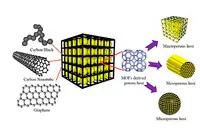Electronics News
Archive : 16 December 2014 год
 As part of the wider attempts to create smaller batteries that can be recharged for longer and which offer more power, researchers at the University of Cambridge, along with a team from the Beijing Institute of Technology, have developed what is described as a 'novel multifunctional sulphur electrode'.
As part of the wider attempts to create smaller batteries that can be recharged for longer and which offer more power, researchers at the University of Cambridge, along with a team from the Beijing Institute of Technology, have developed what is described as a 'novel multifunctional sulphur electrode'.
The device, which combines an energy storage unit and an electron/ion transfer network, is said to be 'extremely promising' and to address issues such as low efficiency and capacity degradation.
The approach uses a metal organic framework (MOF) as a 'template' to produce a conductive porous carbon cage. Sulphur within the cage acts as the host and each sulphur-carbon nanoparticle acts as an energy storage unit.
"Our carbon scaffold acts as a physical barrier to confine the active materials within its porous structure," said research scientist Kai Xi. "This leads to improved cycling stability and high efficiency."
However, the team has also brought graphene into play, 'wrapping' it around the sulphur electrode to speed the transport of electrons and ions.
According to Xi, the work provides a 'basic, but flexible, approach to both enhance the use of sulphur and to improve the cycle stability of batteries'. "Modification of the unit or its framework by doping or polymer coating could take the performance to a whole new level."
By integrating energy storage with an ion/electron framework, the team believes there is now the potential to make high performance energy storage systems that do not involve a structural change to a crystalline solid.
Author
Graham Pitcher
Source: www.newelectronics.co.uk
 Engineering related research and education charity Lloyd's Register Foundation has offered a conditional grant of £10million over five years to support research by the Alan Turing Institute into the engineering applications of big data. The offer, subject to specific areas of research being finalised, follows the Foundation's Foresight report, examining how big data might impact the safety and performance of engineering assets and infrastructure in such areas as energy, transportation and shipping.
Engineering related research and education charity Lloyd's Register Foundation has offered a conditional grant of £10million over five years to support research by the Alan Turing Institute into the engineering applications of big data. The offer, subject to specific areas of research being finalised, follows the Foundation's Foresight report, examining how big data might impact the safety and performance of engineering assets and infrastructure in such areas as energy, transportation and shipping.
Prof Richard Clegg, pictured, the Foundation's managing director, said: "Our report concludes that, within the next five to 10 years, we are going to witness step changes in sensor technology, data driven intelligent systems, computer science and algorithms for data analysis, impacting all aspects of the business life cycle – from design to manufacturing, maintenance to decommissioning.
"This report sets the high level strategic direction and funding priorities for the Foundation in the field of 'data centric engineering'. Big data is going to bridge the gap from monitoring 'what is' to predicting 'what if?'. The Foundation intends to become a major supporter of international research in the field, partnering with organisations including the Engineering and Physical Sciences Research Council."
The Foundation's report has identified four priority action areas: technology road mapping; design for data; codes and standards; and
data analytics.
Professor Philip Nelson, chief executive of the EPSRC, said: "We warmly welcome the Foundation's generous grant offer. Big data has huge potential to impact all areas of society and the economy and investment in research will help realise that potential."
Author
Graham Pitcher
Source: www.newelectronics.co.uk
 Nanoelectronics research centre imec, in partnership with Ghent University, has developed an integrated graphene optical electro absorption modulator (EAM) capable of modulating at 10Gbit/s. According to the organisation, this is an important milestone in the development of high density, low power integrated optical interconnects.
Nanoelectronics research centre imec, in partnership with Ghent University, has developed an integrated graphene optical electro absorption modulator (EAM) capable of modulating at 10Gbit/s. According to the organisation, this is an important milestone in the development of high density, low power integrated optical interconnects.
Imec's graphene-silicon EAM consists of a 50µm long graphene-oxide-silicon capacitor structure implemented on top of a planarised silicon on insulator rib waveguide. It says high quality optical modulation was demonstrated in the device at rates of up to 10Gbit/s over a wavelength range of 80nm centred on 1550nm. No significant changes in performance were seen over temperatures ranging from 20 to 49°C, which imec says implies robust athermal operation.
"Imec has illustrated the huge potential of graphene optical EAMs with respect to thermal, bandwidth and footprint benefits," claimed Philippe Absil, pictured, director of imec's 3D and Optical Technologies department. "Future work will focus on improving the modulation speed of our graphene EAM, similar to the speed obtained in highly optimised Si(Ge) modulators."
Author
Graham Pitcher
Source: www.newelectronics.co.uk

